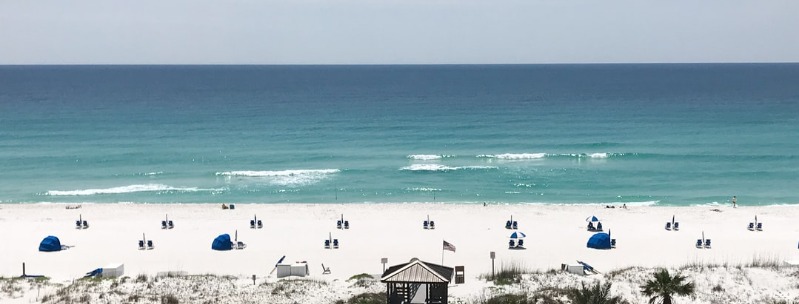Aside from breathtaking sunsets, the best Gulf Coast beaches have the softest sand, clearest waters, the most enjoyable nature trails, and the finest fishing.
Furthermore, Gulf Coast beaches are among the most comfortable water temperatures all year. In the summer, the temperature of the water ranges from around 82 degrees in Destin in June to nearly 87 degrees in Tampa in August.
Clearwater Beach
If you’re looking for sun and sand, you’ll find plenty of both on the 28 miles of slim barrier islands that skirt the Gulf shore of the Pinellas Peninsula.
Here you’ll discover some of the nation’s finest beaches, some of which are protected from development by parks and nature preserves.
Clearwater Beach is a vacationer’s paradise. In addition to some of the most beautiful, broad beaches on Florida’s Gulf Coast, you’ll find all the water-oriented recreation you can imagine and lots of outdoor activities in the Clearwater area.
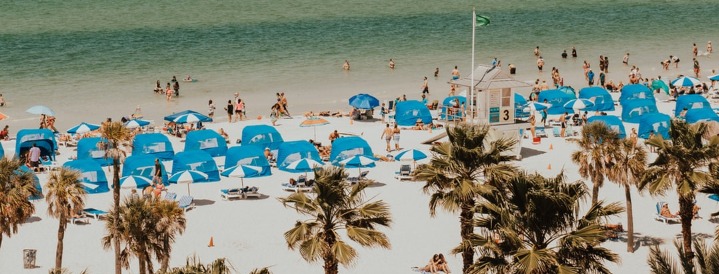
Besides jet skis, water bikes, and parasails, at the Clearwater Beach Marina, you can rent boats for everything from a relaxing sail to a deep-sea fishing adventure.
More than 300 species of fish populate the waters, making the area one of Florida’s premier fishing locales.
At the Clearwater Marine Aquarium, you can enjoy seeing dolphins, otters, and sea turtles and learn ways to help protect them.
The Aquarium’s Marine Life Adventures lets you play, explore and relax on the area’s beautiful beaches, bays, and barrier islands as you help preserve the precious marine environment.
At mealtimes, you will discover the great variety in the cuisine. Try a Gulf-fresh grouper sandwich at a quaint outdoor cafe or fine dining accompanied by a breathtaking waterfront view.
Take in an outdoor concert or local festival in downtown Clearwater. Clearwater’s Jazz Holiday, held in October each year, is one of Florida’s premier jazz festivals.
Destin Beaches
In Destin, there is never a shortage of things to do. Each summer, families can be seen splashing around in the pleasant, brilliant blue water and constructing white sand castles. Get up close and personal with marine life at the Gulfarium Marine Adventure Park, where you can feed penguins and snorkel with dolphins and stingrays. Destin, known as “The World’s Luckiest Fishing Village,” offers world-class sport fishing charters from the HarborWalk Marina.
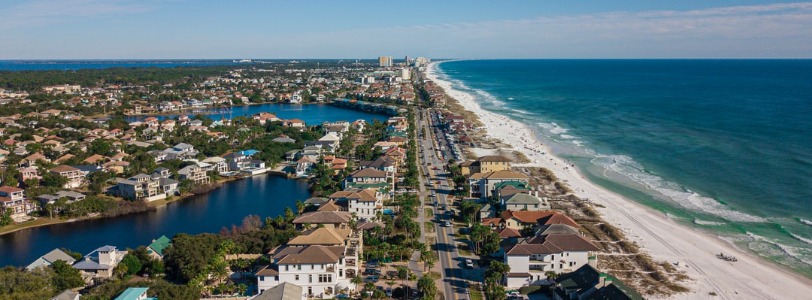
The combination of sun-bleached, shocking white shores that stretch 24 miles like ribboning white satin and rich, emerald-jeweled waters is without a doubt the most enticing distraction on the Emerald Coast. Sprawling shorelines provide seating for dolphin and sandpiper showings, as well as postcard-perfect sunrises and sunsets over the Gulf, courtesy of Mother Nature. More than 60% of the area’s beaches will be preserved in their sweeping, virgin purity for all time.
Fort Myers Beach
Fort Myers, fifty miles south, may lack the elan of Sarasota, but it’s nonetheless one of the up-and-coming communities of the southwest coast.
Fortunately, most of its recent growth has occurred on the north side of the wide Caloosahatchee River, which the town straddles, allowing the traditional center, along the waterway’s south shore, to remain relatively unspoiled.
Still being discovered by the holidaying multitudes, the Fort Myers beaches on Estero Island, fifteen miles south of downtown, are appreciably different in character from the west coast’s more commercialized beach strips, with a cheerful seaside mood.
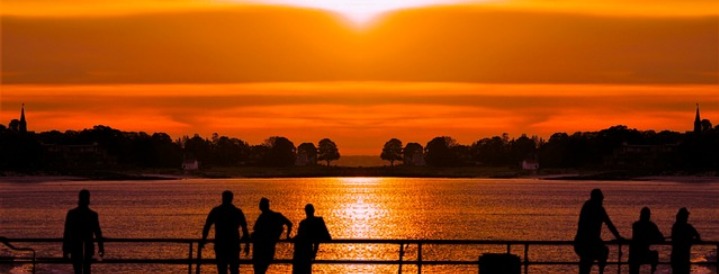
Accommodation is plentiful on and around Estero Boulevard – reached by San Carlos Boulevard, which runs the seven-mile length of the island.
Most activity revolves around the short fishing pier and the Lynne Hall Memorial Park, at the island’s north end.
Estero Island becomes increasingly residential as you press south, Estero Boulevard eventually swinging over a slender causeway onto the barely developed San Carlos Island.
A few miles ahead, at the Lovers Key State Recreation Area, a footpath picks a trail over a couple of mangrove-fringed islands and several mullet-filled creeks to Lovers Key, a secluded beach. If you don’t fancy the walk, a free trolley will transport you between the park entrance and the beach.
The islands of Sanibel and Captiva are virtually impossible to visit unless you have a car and are reached only by crossing a causeway.
However, if you have a spare day the islands offer a wildlife refuge, mangroves, and shell-strewn beaches – for which the island is widely renowned.
In contrast with the smooth beaches along the gulf side of Sanibel Island, the opposite edge comprises shallow bays and creeks, and a vibrant wildlife habitat under the protection of the J.N. “Ding” Darling National Wildlife Refuge.
Fort Walton Beach
Unpretentiously beautiful and refreshingly quaint, Fort Walton Beach is an unassuming and utterly charming seaside resort town.
This slice of Florida’s upper Gulf coast offers an easy pace and gentle hospitality that is as refreshing as its balmy sea breezes. These sun-kissed shores are host to an extensive variety of entertainment and recreational possibilities.
Do your loafing on the white sands of Okaloosa Island, joined to the mainland by the high-rise Brooks Bridge over Santa Rosa Sound. Most resort hotels and amusement parks are grouped around the Gulfarium marine park on U.S. 98, east of the bridge.
Here you’ll find The Boardwalk, a collection of tin-roofed beachside buildings that have a games arcade for the kids, a saloon for adults, covered picnic areas, a summertime snack bar, and a seafood restaurant.
Just to the east, you can use the restrooms, cold-water showers, and other free facilities at Beasley Park, home of the Okaloosa County Visitor Welcome Center.
For those who prefer to explore the great outdoors, the 100 Fathom Curve draws closer to the area than to any other spot on the Gulf, providing exceptional diving, snorkeling, and shelling.
Like its neighbor, Destin, saltwater fishing is a universally recognized sport here, and the bounty of the sea yields cobia, triggerfish, king mackerel, and more in the “Billfish Capital of the World.”
St. Pete Beach
Drab suburbs stretch west from St Petersburg, covering virtually all of the Pinellas peninsula, a bulky thumb of land poking between Tampa Bay and the Gulf of Mexico.
Framing the Gulf side of the peninsula, a 35-mile chain of barrier islands forms the St. Petersburg Beaches, one of Florida’s busiest coastal strips.
When the resorts of Miami Beach lost some of their allure during the 1970s, the St Petersburg beaches grew in popularity with Americans and have since evolved into an established destination for package-holidaying Europeans.
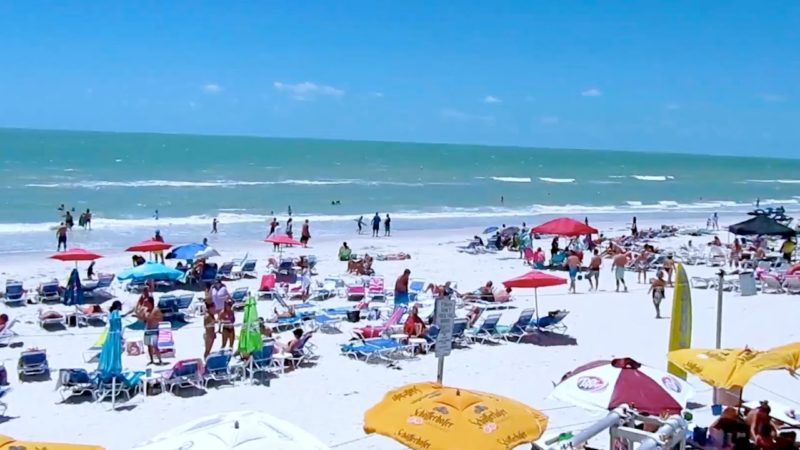
The beaches themselves are beautiful, the sea is warm, and the sunsets are fabulous, yet this in no way is Florida at its best.
In twenty-odd miles of heavily touristed coast, only Pass-a-Grille, at the very southern tip of the barrier island chain, has the look and feel of a genuine community – two miles of tidy houses, cared-for lawns, small shops, and a cluster of bars and restaurants.
At weekends, informed locals come to enjoy one of the area’s liveliest sets of sand. A mile and a half north of Pass-a-Grille, the painfully luxurious Don Cesar Hotel, is a grandiose pink castle, filling seven beachside acres.
Continuing north on Gulf Boulevard brings you into the main section of St. Pete Beach, a string of uninspiring hotels, motels, and eating places.
Further north, Treasure Island is an even less varied tourist territory. An arching drawbridge leads to Madeira Beach, essentially more of the same – although, if you can’t make it to Pass-a-Grille, the beach here justifies a weekend fling.
Much of the northern section of Sand Key, the longest barrier island in the St Petersburg chain and one of the wealthier portions of the coast, is taken up by stylish condos and time-share apartments. It ends with the pretty Sand Key Park, where tall palm trees frame a scintillating strip of sand.
Sand Key Park occupies one bank of Clearwater Pass, across which a belt of sparkling white sands marks the holiday town of Clearwater Beach, whose streets still retain an endearing small-town feel.
Santa Rosa Island
On the east side of the bay from the city lie Pensacola’s real attractions: the glistening beaches and windswept sand dunes of Santa Rosa Island (the barrier island that runs sixty miles from Fort Walton).
Pensacola Beach in particular has everything you’d want from a Gulf Coast beach: mile after mile of fine white sands, water sports rental outlets, a busy fishing pier, and a sprinkling of motels, beachside bars, and snack stands.
A short way west, at the Gulf Islands National Seashore, on Fort Pickens Road (9 am-dusk; cars $4, pedestrians and cyclists $2), vibrant white sands are walled by a nine-mile-long stretch of high, rugged dunes, and the only reminder of civilization is a foliage-encircled campground.
Navarre Beach
Navarre Beach boasts miles of beautiful shoreline rated best in the nation.
Towering sand dunes gracefully slope down to the beaches where the sand is so clean and powdery white, it squeaks under your toes.
Enjoy eight miles of pristine beaches located within the federally protected Gulf Islands National Seashore, extending from Pensacola east along State Road 399 all the way to the southern tip of Santa Rosa Island.
This is the longest continuous stretch of protected beach in Northwest Florida, perfect for sun-seekers, birdwatchers, and shutterbugs.
Plans are evolving in stages for a new state park on the eastern edge of Navarre Beach which will include the addition of picnic pavilions, parking, campsites, a boardwalk over wetland areas, restrooms, showers, a concession stand, a children’s playground, canoe launch, two sound-side piers, and nearshore underwater marine sanctuary in the Gulf.
Public beaches are accessible via the Navarre Toll Bridge (State Road 399) from US Highway 98.
Sarasota Beaches
Rising on a gentle hillside beside the blue waters of Sarasota Bay, Sarasota is one of Florida’s better-off and better-looking towns, and also one of the state’s leading cultural centers.
Most visitors stop by to see the Ringling estate on the town’s northern edge – home of the art-loving millionaire from whom modern Sarasota takes its cue – and the barrier island beaches, a couple of miles away across the bay.
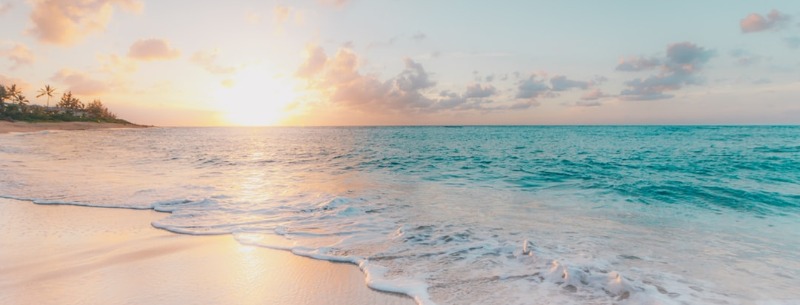
Increasingly the stamping ground of European package tourists spilling south from the St Petersburg beaches, the white sands of the Sarasota beaches are gradually losing much of their scenic appeal to towering condos.
For all that, they’re worth a day of anybody’s time, with the two islands on which they lie, Lido Key and Siesta Key, accessible from the mainland. There is, however, no direct link between them. The third island, Longboat Key, is primarily residential.
The Ringling Causeway crosses the yacht-filled Sarasota Bay from the foot of Main Street to Lido Key and flows into St. Armand’s Circle, a roundabout ringed by upmarket shops and restaurants dotted with some of Ringling’s replica classical statuary.
Continuing south along Benjamin Franklin Drive you come to the island’s most reachable beaches, ending after two miles at the more attractive South Lido Park, a belt of dazzlingly bright sand beyond a large, grassy park.
The bulbous northerly section of tadpole-shaped Siesta Key, reached by Siesta Drive off US-41, about five miles south of downtown Sarasota, holds the bulk of the island’s residents, with streets that twist around a network of canals.
To escape the crowds at Siesta Key Beach, beside Ocean Beach Boulevard, continue south past Crescent Beach, and follow Midnight Pass Road for six miles to Turtle Beach, a small body of sand that has the island’s only campground.
Panama City Beach
Follow Hwy-98 fifty miles west of Apalachicola and you’ll hit the orgy of motels, go-kart tracks, mini-golf courses, and amusement parks that is Panama City Beach.
This beach is entirely without pretension, but it capitalizes blatantly on the appeal of its 27-mile stretch of white sand.
The whole place is as commercial as can be, but with the shops, bars and restaurants all trying to undercut one another, there are some great bargains to be found.

That said, throughout the lively summer, accommodation costs are high and bookings essential. In winter, prices drop and visitors are fewer; most are Canadians and – increasingly – Europeans, many of whom have no problems sunbathing and swimming in the cool temperatures.
Getting a tan, running yourself ragged at beach sports, and going hammer-and-tongs at the nightlife are the main concerns in Panama City Beach.
If you get restless, try go-karting, jet-skiing, or parasailing; otherwise, visit one of the amusement parks or go on a fishing trip.
For scuba divers, several explorable shipwrecks litter the area; get details from any of the numerous dive shops.
